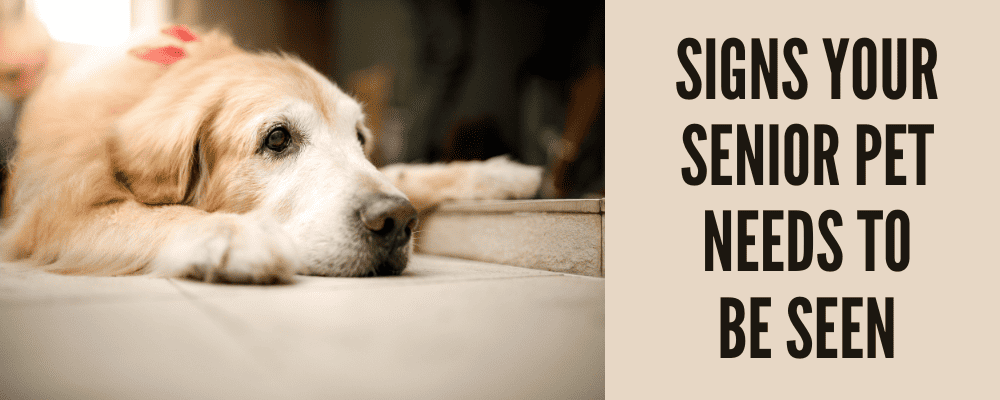Everybody gets old, including your dog. That adorable little pup that grew into your constant companion may be showing signs of getting old, both physical and mental. Different breeds and sizes of dog age at different rates. A large breed like a Great Dane is considered senior at around 6 years old. A small dog, like a Chihuahua, for example, may not be considered old until they are ten years old. The more tuned-in you are to the typical signs, the sooner you can help your dog age gracefully.
Physical Signs of Aging in Dogs
How does aging in dogs manifest? Here are some possibilities you might notice as your dog gets older:
- Cloudy eyes or difficulty seeing: Eye cloudiness can happen so gradually that you might not notice it right away. While it’s a fairly common occurrence in senior dogs and may not affect vision, it may also be a sign of canine cataracts or other eye diseases, most of which are easily treatable. Your dog may start bumping into things or have trouble locating familiar objects on the floor. This could signal vision loss.
- Horrible breath: While bad breath in dogs can be common at any age, if your dog seems to suddenly have awful breath, it could indicate gum disease, tooth decay, or oral infection. The immune system weakens as dogs age and they aren’t able to fight off infections as easily as they did when they were younger. Along with a good dental cleaning, your vet may decide to do blood work to rule out infection.
- Slowing down or difficulty getting around: An older dog may have trouble with stairs, jumping into the car, or just getting up after a nap. You might notice weakness in their back legs. While we all slow down as we age, your dog’s mobility issues could be caused by arthritis or another degenerative disease. Along with any pain or arthritis medication or doggy dietary supplements your vet recommends, you will have to adjust your dog’s exercise regimen to slower and shorter walks or a new exercise routine. Swimming with your dog, for example, is gentle on the body and many dogs love it.
- New lumps and bumps: Some dogs are prone to harmless fatty lipomas,and these lumps under the skin are more common as dogs age. However, your vet should check any new lumps on your dog to rule out a malignant tumor.
- Change in weight: It’s not surprising that older, less active dogs sometimes gain weight. You may have to adjust your dog’s diet and exercise to maintain a healthy weight. However, you should also pay attention if your senior dog loses weight. This weight loss could be the result of reduced muscle mass, which is common in older dogs, or it might be caused by reduced appetite, poor absorption of nutrients, or a digestive illness. If your dog loses more than 10% of their body weight in a few months, or even in a year, consult your vet.
- Incontinence or difficulty peeing or pooping: If your dog suddenly seems to forget their house training or seems to strain when urinating, these could be signs of a urinary tract infection or kidney disease. However, urinary incontinence is not unusual in elderly female dogs and there are incontinence medications that can help.
Behavioral and Mental Signs of Aging in Dogs
Physical changes aren’t the only differences you may notice in aging dogs. Changes in behavior can signal an underlying physical problem or may be a normal sign of aging. For example, if your sweet dog has suddenly turned grumpy, your dog may be in pain caused by arthritis or be experiencing some other physical discomfort. Or your high-energy companion may be sleeping hours a day. Older dogs need more sleep, but if he seems lethargic when awake, that could be the sign of a problem.
Changes in behavior may also be the result of canine cognitive dysfunction syndrome (CCDS). According to a one study, CCDS affects 14% to 35% of dogs over 8 eight years old. As a dementia that is similar to Alzheimer’s in humans, CCDS can bring about pronounced changes in your dog’s everyday behavior, including:
- Fear of familiar people or objects
- Changes in the sleeping-waking cycle, including restlessness or pacing at night
- Increased barking and vocalization
- Repetitive or compulsive behaviors
- Forgetting commands and cues that your dog once knew
- Peeing or pooping in the house
- Increased anxiety
- Confusion and disorientation
- Marked change in your dog’s activity level
The single most important thing you can do is check with your vet if you see any of these physical or mental changes in your pet. The vet can determine any underlying medical causes and prescribe treatments. They can also help you make some decisions about your dog’s care going forward, such as changes in diet and exercise, and changes you can make around the house or in their daily routine.
